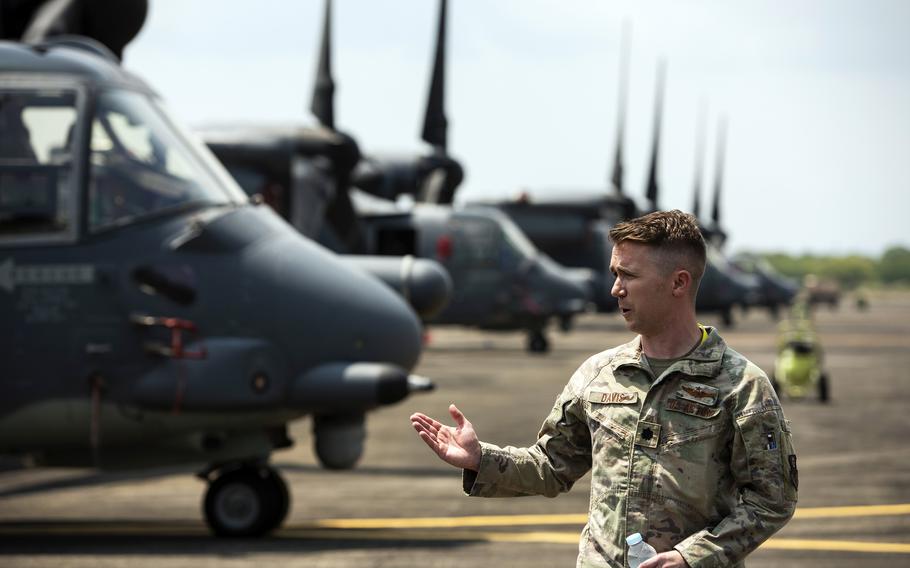
Air Force Lt. Col. Matthew Davis, commander of the 21st Special Operations Squadron at Yokota Air Base in western Tokyo, speaks to Philippine sailors about the CV-22 Osprey at the former home of Naval Air Station Cubi Point, Sunday, April 23, 2023. (Jonathan Snyder/Stars and Stripes)
SUBIC BAY, Philippines — It’s been a decade since Air Force Lt. Col. Matthew Davis helped deliver aid and evacuate people after a massive typhoon swept over towns and villages on the Philippines’ eastern coast.
In those days, he was a young captain flying an MC-130P Combat Shadow on relief missions out of Villamor Air Base, Manila, to places such as Tacloban on the island of Leyte, which was flattened by a typhoon in November 2013.
Davis was one of 13,400 U.S. military personnel who participated, along with 66 aircraft and 12 naval vessels, in Operation Damayan.
The American relief effort delivered vast quantities of emergency supplies and evacuated more than 21,000 survivors. Winds of 100 mph and a storm surge of rushing seawater reached the second floor of some buildings in Tacloban.
This month, Davis — now stationed at Yokota Air Base, Japan — is back in the islands as a lieutenant colonel flying CV-22 Osprey aircraft and leading a special operations task force during the annual Balikatan exercise. About 17,000 U.S. and Filipino troops are taking part in the drills.
The Damayan relief missions involved night operations to deliver water and aid to airports at the devastated towns, Davis said.
“We flew out of there with as many IDPs (internally displaced persons) as we could fit inside the aircraft,” he recalled Sunday at Cubi Point, a former U.S. naval air station in Subic Bay, where his task force is operating during Balikatan.
Davis transferred to the Osprey in 2015, when the Air Force retired the Combat Shadow.
At Cubi Point, he was showing four Ospreys to a group of local journalists and Filipino sailors. One of the sailors, it turned out, was a typhoon survivor.
“I am a victim of Typhoon Yolanda,” Philippine navy Lt. Giovani Badidles said during the tour, using the Filipino name for Typhoon Haiyan.
The Tacloban local said his family’s home, near the town’s airport, was inundated by the storm.
The typhoon killed more than 6,000 people, damaged 40,000 homes and left 25,000 families homeless in Tacloban, local officials said after the typhoon.
“I saw these aircraft during 2013,” Badidles said of the Ospreys.
His family boarded one of the American Ospreys and evacuated to Manila, he recalled.
The Osprey, Badidles said, is his favorite aircraft. However, he doesn’t think the Philippine navy will acquire them any time soon, since the country’s warships aren’t as big as U.S. Navy vessels and may lack space for them to land.